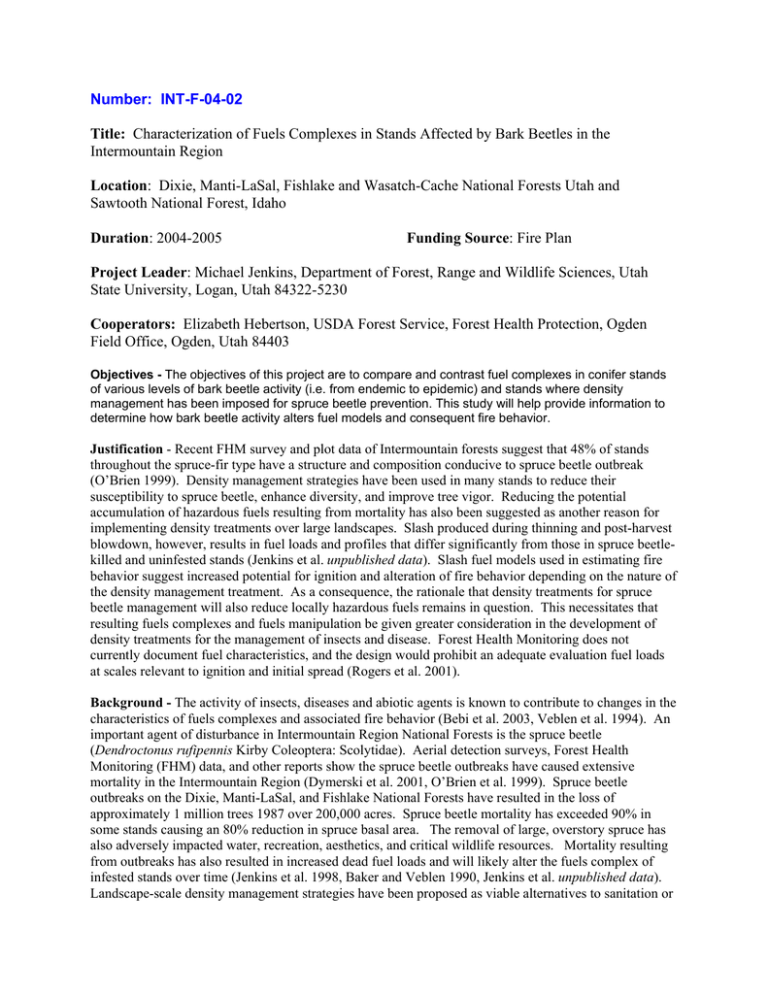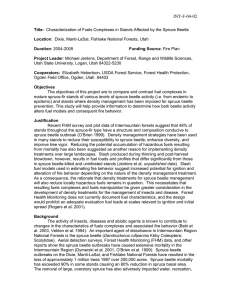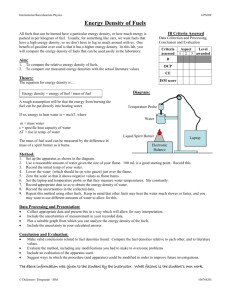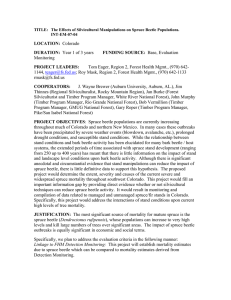Number: INT-F-04-02 Intermountain Region Sawtooth National Forest, Idaho
advertisement

Number: INT-F-04-02 Title: Characterization of Fuels Complexes in Stands Affected by Bark Beetles in the Intermountain Region Location: Dixie, Manti-LaSal, Fishlake and Wasatch-Cache National Forests Utah and Sawtooth National Forest, Idaho Duration: 2004-2005 Funding Source: Fire Plan Project Leader: Michael Jenkins, Department of Forest, Range and Wildlife Sciences, Utah State University, Logan, Utah 84322-5230 Cooperators: Elizabeth Hebertson, USDA Forest Service, Forest Health Protection, Ogden Field Office, Ogden, Utah 84403 Objectives - The objectives of this project are to compare and contrast fuel complexes in conifer stands of various levels of bark beetle activity (i.e. from endemic to epidemic) and stands where density management has been imposed for spruce beetle prevention. This study will help provide information to determine how bark beetle activity alters fuel models and consequent fire behavior. Justification - Recent FHM survey and plot data of Intermountain forests suggest that 48% of stands throughout the spruce-fir type have a structure and composition conducive to spruce beetle outbreak (O’Brien 1999). Density management strategies have been used in many stands to reduce their susceptibility to spruce beetle, enhance diversity, and improve tree vigor. Reducing the potential accumulation of hazardous fuels resulting from mortality has also been suggested as another reason for implementing density treatments over large landscapes. Slash produced during thinning and post-harvest blowdown, however, results in fuel loads and profiles that differ significantly from those in spruce beetlekilled and uninfested stands (Jenkins et al. unpublished data). Slash fuel models used in estimating fire behavior suggest increased potential for ignition and alteration of fire behavior depending on the nature of the density management treatment. As a consequence, the rationale that density treatments for spruce beetle management will also reduce locally hazardous fuels remains in question. This necessitates that resulting fuels complexes and fuels manipulation be given greater consideration in the development of density treatments for the management of insects and disease. Forest Health Monitoring does not currently document fuel characteristics, and the design would prohibit an adequate evaluation fuel loads at scales relevant to ignition and initial spread (Rogers et al. 2001). Background - The activity of insects, diseases and abiotic agents is known to contribute to changes in the characteristics of fuels complexes and associated fire behavior (Bebi et al. 2003, Veblen et al. 1994). An important agent of disturbance in Intermountain Region National Forests is the spruce beetle (Dendroctonus rufipennis Kirby Coleoptera: Scolytidae). Aerial detection surveys, Forest Health Monitoring (FHM) data, and other reports show the spruce beetle outbreaks have caused extensive mortality in the Intermountain Region (Dymerski et al. 2001, O’Brien et al. 1999). Spruce beetle outbreaks on the Dixie, Manti-LaSal, and Fishlake National Forests have resulted in the loss of approximately 1 million trees 1987 over 200,000 acres. Spruce beetle mortality has exceeded 90% in some stands causing an 80% reduction in spruce basal area. The removal of large, overstory spruce has also adversely impacted water, recreation, aesthetics, and critical wildlife resources. Mortality resulting from outbreaks has also resulted in increased dead fuel loads and will likely alter the fuels complex of infested stands over time (Jenkins et al. 1998, Baker and Veblen 1990, Jenkins et al. unpublished data). Landscape-scale density management strategies have been proposed as viable alternatives to sanitation or salvage for managing insect and disease outbreaks. The effect of outbreaks and various density treatments on fuels complexes, or fuels development, however, is not known. Materials and Methods - Forest Health Monitoring and aerial detection survey data will be used to locate stands susceptible to spruce beetle outbreak, treated stands, and stands where spruce beetle populations have recently reached outbreak levels. Permanent plots will then be systematically established in these various stands. From each plot center, six 35’ Brown’s planar intersect transects for dead and down fuel measurements (Brown 1974). Fuels transects will be randomly established from the end of 100’ lines that radiate outward from plot center at 60° intervals. Metal stakes will permanently locate the beginning of each fuels transect for future measurements. Transects will also be photographed for documenting fuel arrangements and profiles. Additional transect information collected will include slope angle and aspect. Analysis of variance will be used to test mean differences of fuel loads in treated and untreated plots. Fuels inventory and appraisal will provide information needed for fuel model designation. Uninfested, coniferous timber stands generally fall into fire behavior fuel model 8. Bark beetle outbreaks typically convert these stands to fuel model 10 while thinning can create fuel conditions typical of slash fuel models 11 or 12. Under constant conditions of topography, wind and fuel moisture fire behavior will be predicted to vary widely within the different fuel model conditions present. Products: 1) guidelines for improved evaluation/assessment of fuels in bark beetle affected stands, 2) poster/presentation 3) peer-reviewed publication Progress: Objectives and geographic distribution of plots have been expanded to include lodgepole pine/mountain pine beetle and Douglas-fir/Douglas-fir bark beetle. Data have been collected from approximately 100 plots at various bark beetle population levels in lodgepole pine and Douglas-fir in central and northern Utah and southcentral Idaho. Accomplishments: A poster describing objectives and sampling procedureshas been prepared and will be presented to FHP personnel in Bend, Oregon in October 2004. Schedule of Activities: Budget for 2005 Items Salary Travel Equipment/Supplies TOTAL FHM 18,000 6,600 2,000 $27,600 2004-plot establishment/data collection 2005- complete data collection, data analyses, completion of products 2006-publication of results Other Funding 4,600 250 Source R4 FHP $4,850 2






